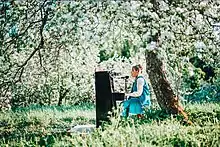.jpg.webp)

Mari Kalkun (born 1 April 1986)[1] is an Estonian singer and musician who specializes in contemporary folk music. She has performed at home and abroad with the ensemble Runorum, releasing several recordings since 2007. In 2013, she was voted the best singer at Estonia's Ethno Music Awards.[2] Her widely acclaimed 2018 album Ilmamõtsan consists of the songs inspired by Estonian traditional folk music, especially that from the villages of Kalkun's native Võru in south-eastern Estonia.[3][4][5]
Biography
Born on 1 April 1986, Mari Kalkun was brought up in the Võru district in south-eastern Estonia where since her childhood she has been inspired by the surrounding woodlands, birds and bogs.[3] Her cousin is musician and folkorist Andreas Kalkun, with whom she has also collaborated.[6]
She first studied cultural management at the Viljandi Culture Academy,[7] followed by music studies at the Estonian Academy of Music and Theatre. She was an exchange student at the Sibelius Academy in Helsinki, Finland, graduating with a master's degree in traditional singing.[8] She has developed her specific style of combining folk music with jazz.[9]
Kalkun not only sings but composes her own music and plays several instruments including the Estonian zither, piano, accordion and guitar. She released her first solo album Üü tulõk (Arrival of the Night) in 2007. Thanks to its success, she was invited to concerts in France, the UK, Finland and Russia. In 2009, she performed in Japan together with the Estonian artist Pastacas where a recording of her music was also released.[9]
Later recordings include Dear Rain (2010), Tii ilo (2015) together with her Finnish band Runorum, and Upa-upa ubinakõnõ (2015) in her native Võru dialect.[2] Ilmamõtsan was released in November 2017. It consists of 12 songs in Estonian and Võru, most of them written by Kalkun inspired by local poets.[10]
References
- ↑ "Mari Kalkun". BBC. Retrieved 9 May 2019.
- 1 2 "Mari Kalkun". Nordic Notes. Retrieved 9 May 2019.
- 1 2 Friedrich, Grit (4 April 2019). "Filigrane Klangwelten aus Estland" (in German). Deutschlandfunk. Retrieved 9 May 2019.
- ↑ Spencer, Neil (24 June 2018). "Mari Kalkun: Ilmamõtsan review – mesmerising Estonian forest folk". The Guardian. Retrieved 9 May 2019.
- ↑ Harness, Greg (2018). "Mari Kalkun: Ilmamõtsan". RootsWorld. Retrieved 9 May 2019.
- ↑ "Mari Kalkuni uus sooloplaat "Ilmamõtsan" muugib lahti metsa ja maailma". Võrumaa arenduskeskus (in Estonian). 10 November 2017. Retrieved 28 January 2021.
- ↑ Koppinen, Mari (2019-07-29). "Viljandista on kehittynyt Viron oma Kaustinen, jonka leppoisilla kansanmusiikkifestivaaleilla presidenttikin äityy leikkimään kuurupiiloa". Helsingin Sanomat (in Finnish). Retrieved 2022-07-25.
- ↑ "Mari Kalkun – "La musica ereditata dalla tradizione degli antenati è la storia che coesiste con la terra e la natura, parla al suono della mente, dell'anima."". Musicaest (in Italian). 2018-10-19. Retrieved 2022-07-25.
- 1 2 Rooste, Jürgen (7 April 2013). "Rändlaulik Mari Kalkun - andekas nagu kurat (8)" (in Estonian). Maaleht. Retrieved 9 May 2019.
- ↑ "Mari Kalkun" (in Estonian). Allstarz.ee. Retrieved 9 May 2019.